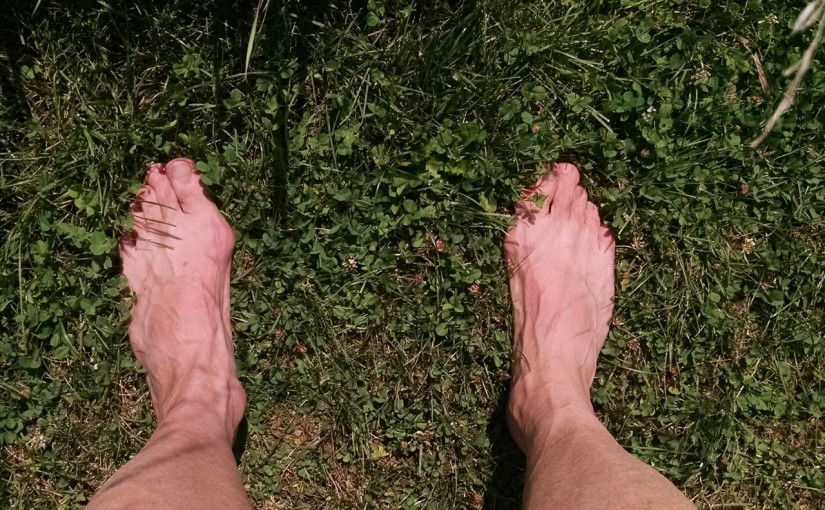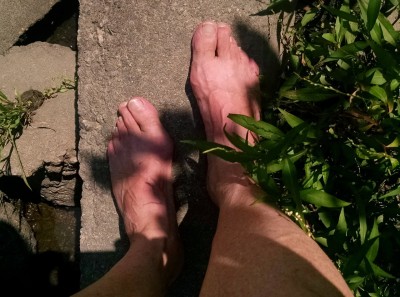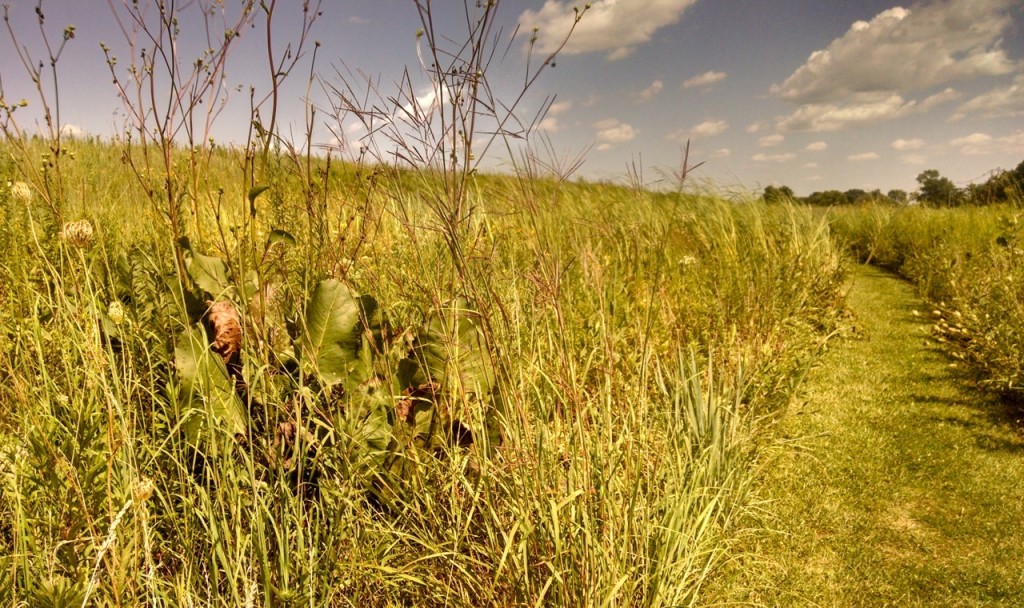A couple of years ago, I switched to “barefoot” running—with those quote marks there because I was not actually running with bare feet. Rather, I changed my stride, trying to match the stride of someone who was barefoot, landing on the forefoot rather than the heel.
I bought two pairs of minimalist running shoes (Road Glove and Trail Glove, both by Merrell), both featuring thin, flexible soles with zero drop (that is, the sole was the same thickness from the heel to the toe).
The changed stride demanded a lot more strength and endurance in my calf muscles, which took most of the summer to develop, but it felt natural right from the start. In my third summer of “barefoot” running, I’ve had no hint of running injuries, while hitting distance benchmarks that I haven’t hit in years.
However, my ongoing explorations of natural movement have convinced me that walking and running with actually bare feet probably offer some advantages.
The interwebs are full of advocates of barefoot walking and barefoot running, and frankly they’re kind of scary. They tend to be hugely invested in the idea that everybody who wears shoes is totally missing the boat. Their articles on the subject are full of references to the number of bones in your feet (26) and the number of joints (33), with the point being that there are extensive structures in your foot to deal with the challenges of walking on uneven surfaces. Wear shoes all the time, and those structures lose that capacity. The joints adapt to scarcely bending, the small muscles in the foot adapt to the tiny range of motion available inside a shoe. These things are arguably bad, even if the tone of the barefoot advocates sometimes seems a bit overwrought.
I started walking outside with bare feet some time in the late spring. I don’t remember exactly when, but I do remember going easy on the barefoot walking in the couple of weeks leading up to our big hike, so we must have already been doing it by early June. (My concern was that even a very minor injury—stepping on a thorn, bruising my foot on a rock, stubbing my toe—might be enough to keep me from being able to walk 33 miles.)
Once the big hike was over, I resumed my program of gradually increasing my barefoot walking, first just around the block that includes our townhouse, then more broadly in Winfield Village, then to nearby parks and natural areas.
And somewhere along the way, I started to understand the fervor of those barefoot advocates. Walking barefoot is a transformative experience, in a way that’s hard to make sense of if you only walk in shoes.
First of all, it brought back memories of being a little boy. I spent as much time as possible barefoot as a boy, and (because my parents thought that was fine) that ended up being a whole lot of time. Crossing the parking lots here in Winfield Village—walking on the small bits of grit and gravel that accumulate anywhere cars drive—hurt my feet in exactly the same way they hurt each spring the first few times I crossed Huron Street at the beginning of barefoot season when I was a boy. Crossing blacktop that’s been baking under a hot sun is another pain that’s as fresh in memory as it is distant in years. So is stepping on a thistle. Those things—and the wonderful feeling of stepping from hot asphalt into cool grass—were all things I’d not thought of in 40 years.
Second, the adaptations to walking barefoot are different than I’d imagined them being. Somehow I had the idea that I’d “toughen up” the soles of my feet, and that would protect them from pointy rocks and such. That is happening, but it turns out to be the least important part of adapting. Much more important is recovering enough range of motion in those 33 joints to allow the foot to conform to an uneven surface. Experiencing that process—feeling joints in my feet move in ways that they haven’t moved in decades—has been fascinating.
Third, paying some extra attention to my feet has made me notice that I don’t have nearly as much control over my feet (and especially my toes) as I ought to. For example, although I can raise or lower my big toe independent of the other four, I can only just barely move the other four as anything other than a group. My toes don’t bend back far enough for me to be able to transition from a deep knee bend to kneeling. (This is something that was noticed by instructors a couple of different times when I was studying a martial art of the sort that involve kicking, but the observation never came with a plan for how to improve my toe flexibility.) They’re also quite inflexible bending forward.
Fourth, bare feet are more stable. I mentioned in an earlier post that crossing the weir behind Winfield Village was challenging. I’ve been practicing, and have gotten pretty good at it in both hiking boots and in my minimalist running shoes, but it sure is easier in bare feet.
The adaptations to barefoot walking are taking longer than I remember them taking when I was a boy—or maybe they aren’t. I mean, it probably took me two or three years to go from crawling to being a toddler, to running around the yard barefoot, to being able to walk across the street barefoot. Perhaps now, after 40 years of virtually never going outdoors with barefeet, I should not be surprised if it ends up taking two or three years once again.
Finally, today, three years after switching to “barefoot” running, I actually tried barefoot running. I didn’t run very fast or very far—I spent 33 minutes to go about a mile. I walked parts of the path, as well as stopping to take pictures, and to exercise my squats briefly on the other side of the weir. Even with the caveats: barefoot running.
Oh—I also saw a Great blue heron, and got some nice pictures of the prairie. Here’s one:




Very interesting to read this, Phillip! I have not been out of shoes for years, even around the house. I was lucky enough to spend a week at the beach in Florida and two weeks near Sleeping Bear Dunes in northern Michigan this summer and spent more time barefoot than I had in years. I started it mainly to wear off all the thick dry skin on my toes and heels. That worked like a charm, but the added benefit was feeling the whole of my foot being used. I also liked the feeling of being directly in contact with the earth.
Yes! Back in 2008 or so, I spent a week in St. Croix and did a lot of barefoot walking.
It was all on the beach, or the lawn of resort where we were staying, so there just about weren’t any hazards of the sort that require toughening your feet up, so it didn’t have the memory-jogging effect of reminding me of early spring days in my boyhood. Still did wonders for my feet (which back in those pre-taiji days suffered from plantar fasciitis.)